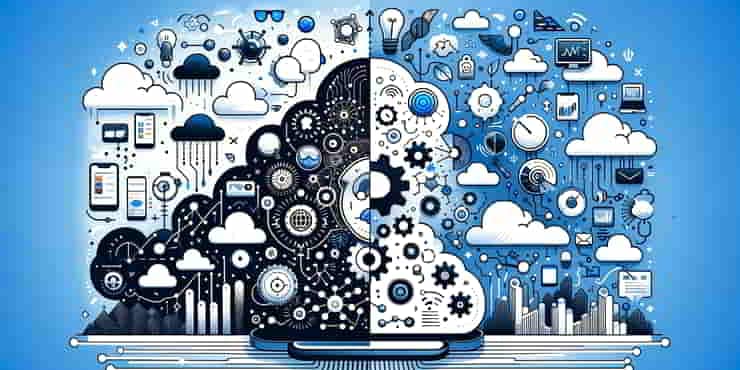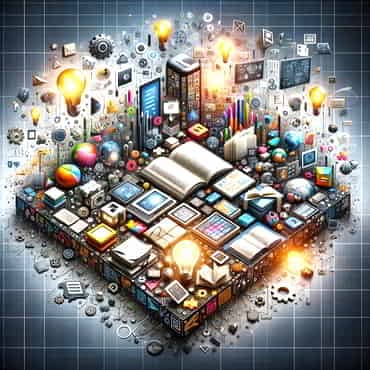The Impact of Technology on Productivity: Weighing Pros and Cons

Estimated reading time: 6 Min
The impact of technology on productivity has been revolutionary since before the internet and now we have AI tools! Here are some of the Pros and Cons.
During my lifetime, technology has evolved into a cornerstone, shaping how tasks are completed, how information is accessed, and how individuals communicate and collaborate.
Yet, as with any significant change, the impact of technology on productivity is not one-dimensional. It brings a host of advantages that can dramatically increase efficiency, but it also presents challenges that can hinder performance if not managed carefully.
This article aims to explore these factors, shedding light on the pros and cons of technology in the context of productivity.
The Pros of the Impact of Technology on Productivity
Enhanced Efficiency and Speed
One of the most significant benefits technology offers is the remarkable increase in efficiency and speed at which tasks can be performed.
Automation, digital tools, and, relatively recently, AI tools, have redefined traditional workflows, allowing for processes that once took hours to be completed in a fraction of the time.
Software solutions automate repetitive tasks, freeing up valuable time for users to focus on more complex and creative work.
For example, accounting software can manage invoices and payroll, while project management tools can streamline the planning and execution of projects.
This shift not only speeds up operations but also reduces the margin for error, leading to more reliable outcomes.
Improved Access to Information
The advent of search engines and comprehensive databases and now easy access to AI based tools has transformed opportunities for research and information gathering.
I remember the days, less than 25 years ago, when it was necessary to sift through physical archives or wait for expert consultations to access critical data.

Today, there’s a wealth of information available at our fingertips, making research quicker, more accurate, and far-reaching.
This accessibility supports better decision-making and innovation, as individuals can easily find and leverage the latest data, studies, and trends relevant to their fields.
Moreover, the ability to access a wide range of information encourages continuous learning and adaptability, essential traits for developing a growth mindset.
These advancements in technology have undeniably propelled productivity forward, offering tools and resources that enable work to be done more efficiently and effectively than ever before.
However, to fully harness these benefits, it is necessary to learn digital skills with a mindful approach, balancing the use of technology to enhance productivity without succumbing to its potential pitfalls.
Flexibility in Work Arrangements
Technology has been a game-changer in enabling flexibility within work arrangements, significantly impacting where, when, and how we work.
The rise of cloud computing, mobile devices, and robust internet services has made remote working a viable and often preferred option for many.
This shift allows employees to manage their work schedules around their personal lives, leading to improved work-life balance, reduced commute times, and, ultimately, enhanced job satisfaction and productivity.
Companies can also tap into a global talent pool, hiring the best individuals for the job regardless of their geographical location.
This level of flexibility, supported by video conferencing tools, collaboration platforms, and secure remote access to company networks, ensures that teams can work efficiently, regardless of physical distances.
The Cons of the Impact of Technology on Productivity
Distractions at Your Fingertips

While technology provides tools for increased productivity, it also introduces a world of distractions.
Social media, online videos, and instant messaging apps can easily divert attention from work, leading to significant time wastage.
The constant bombardment of notifications and the temptation to check updates can fragment focus, making it challenging to engage deeply with tasks at hand.
This environment of continuous distraction not only decreases productivity but can also lead to increased stress as individuals struggle to meet deadlines or manage their workload effectively.
Overreliance on Technology
An overdependence on technology can lead to potential issues, including skill degradation and a reduced ability to perform tasks without technological assistance.
As AI tools and software become more sophisticated, there’s a real risk that basic skills, such as mental arithmetic or manual problem-solving, and basic writing may diminish.
Furthermore, overreliance can lead to complacency, where critical thinking is side-lined in favour of automated solutions.
This shift can hinder creativity and innovation, as the readiness to rely on technology overshadows the need to develop and apply human intellect.
In addition, for writers, there’s a natural knock-on effect to readers who believe they are reading human thoughts but in reality can be being served text generated by an AI tool.
Privacy and Security Concerns
The integration of technology into every facet of work life brings with it significant privacy and security concerns.
Cyber threats, such as data breaches, phishing attacks, and ransomware, can severely disrupt productivity, costing time and resources to address.
Companies and individuals must invest in robust security measures and remain vigilant to protect sensitive information.
This necessity adds a layer of complexity to working digitally, as maintaining high-security standards requires constant updates and monitoring, diverting resources from productive tasks.
The Digital Divide
The digital divide refers to the gap between those who have easy access to technology and the internet and those who do not.
This divide can significantly impact productivity, as individuals or regions with limited access to technology are at a disadvantage.
The disparity can hinder educational opportunities, employment prospects, and the ability to participate in the digital economy.
Addressing the digital divide is essential to ensure that the benefits of technology are equitably distributed, enabling all segments of society to achieve their productive potential.
These cons highlight the need for a balanced approach to technology use in the workplace, where the benefits are maximized, and the drawbacks are carefully managed. By acknowledging these challenges, individuals and organizations can take proactive steps to mitigate the negative impacts of technology on productivity.
Balancing Technology and Productivity
The relationship between technology and productivity is complex, requiring a deliberate and thoughtful approach to harness the benefits while controlling the drawbacks.
Achieving this balance involves setting clear boundaries, embracing technology mindfully, and committing to continuous learning and adaptation.
Setting Boundaries
To manage digital distractions and maintain focus, it’s essential to establish boundaries around technology use. Here are some tips:
- Designate tech-free times
Allocate specific hours of the day as technology-free, allowing you to concentrate on tasks without interruptions. - Use productivity apps
Leverage apps that limit access to distracting sites during work hours, helping you stay on track. - Create a dedicated workspace
Having a physical space for work can help minimize distractions and signal your brain that it’s time to focus. - Set notification rules
Customise your device settings to limit notifications to essential communications during work hours, reducing the temptation to check your phone constantly.
Embracing Technology Mindfully
Choosing and using technology mindfully ensures that it serves to enhance rather than detract from productivity. Consider these strategies:
- Assess tools regularly
Regularly evaluate whether a tool or app is serving its intended purpose or if it’s becoming a distraction or redundancy. - Prioritise ease of use
Choose technologies that integrate seamlessly into your workflow and don’t require excessive management. - Seek feedback
Regularly solicit feedback from team members on the effectiveness of tools and technologies in place, making adjustments as needed.
Continuous Learning and Adaptation
Technology is ever-evolving, and staying abreast of new developments is a challenge but essential. Encouragement for ongoing skill development includes:
- Invest in training
Regularly update your skills to match the latest technology trends relevant to your field. - Stay curious
Foster a mindset of curiosity and openness to experimenting with new tools that could enhance productivity. - Embrace change
View technological advancements as opportunities for growth and improvement, rather than obstacles.
Summary
The impact of technology on productivity has been profound, offering the potential to significantly enhance efficiency and flexibility.
However, without careful management, the drawbacks can overshadow these benefits.
By setting boundaries, embracing technology mindfully, and committing to continuous learning, individuals and organizations can maximize the positive aspects of technology.
This balanced approach ensures that technology serves as a tool for enhancement rather than a source of distraction or inequality.
As you explore advancements in technology, let this article serve as a call to action.
Evaluate your own use of technology and consider adjustments to ensure that it contributes positively to your productivity.
The goal is not to shun technology but to leverage it in ways that support our work, enhance our capabilities, and ultimately, improve our quality of life.
So, what is your point of view? Please leave you opinion in the comments.
🙂
Richard






